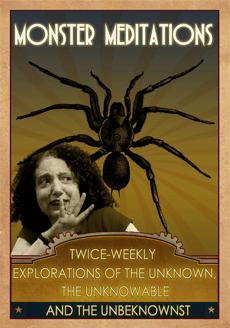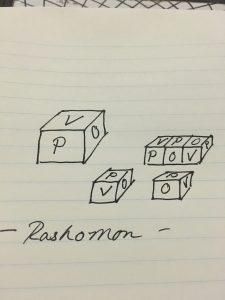From the first row of the jury box, you could see the fabulous socks & shoes worn by the defense attorney. Unfortunately, I was seated in the back row. Over and over again in my notes (on a pad that never left the courtroom and with pages shredded after the conclusion of the trial) I scribbled variations on the concept of point-of-view. During deliberations, the juror to my right asked me what my POV boxes meant. She laughed at my answer, but smiled in recognition of reality.
Everyone involved in that trial brought a POV filled to the brim with past experiences, ideas, fantasies, nightmares, assumptions, and needs. From the woman that brought sweet treats (chocolates & cookies) to share while sharing her obvious bias, to the man who acted as mediator when things got heated while, with subtle sleight of verbal hand, steering the discussion in his direction. As the most experienced of the jurors, I reminded everyone that things can get angry, manipulative and even violent. There was no violence, but voices were raised.
Even mine. What made me angry? From the opening moments of the trial and through the jury instructions from the judge, we were reminded that there was a difference between the narratives presented by the opposing attorneys (the opening and closing arguments) and evidence. The stories posited by the two sides were drawn from inferences that we could accept or reject. Both lawyers told us stories with beginnings, middles and ends. Neither story was backed by a complete foundation of evidence. These stories were supported by bits & pieces of evidence strung together with whispers and assumptions, not facts.
I wouldn’t be surprised if Sartre was serving on a jury when he wrote, “Hell is other people.”
Parsing the evidence from the inference is difficult when the most memorable statements in course of the trial are the stories told by the lawyers. The prosecutor insisted that the strange chain of events started with “bullying” by the defendant and on-going conflicts between poor, immigrant shopkeepers and the peddlers that operate on the street (no rent, no taxes, no insurance). The defense said it was the Hatfields & the McCoys with racist overtones. When one juror (educated, wealthy & relatively young) didn’t understand the reference to one of the most famous feuds in American history, I realized that my POV was stretched to the limit. If there is no common history, there’s little else to make us understand one another.
In the end, I think we came to a logical and fair verdict. Glad I won’t be called again for years!






Ugh, you poor thing. -knock on wood and I hope I don’t jinx myself- I’ve never been called for jury duty and I’m more than happy for it to stay that way!
How anyone ever reaches consensus I’ll never know. ‘Herding cats’ might be easier. Even assuming that everyone on the jury is capable of understanding the technical details of the evidence, a lot of people simply don’t respond to logic. Or, as with your juror, lack the historical context to understand the allusion.
Having served on a regular criminal court jury that became scary during deliberations and three Grand Juries (in New York State, the Grand Jury is used to determine if there is enough evidence to go forward with a trial, most serve for half days for an entire month.. yes, you read that right, an entire month!) and been called for duty but passed over for service a few times, I’m practically an expert!
Even in this relatively good jury, there were interesting fractures in the process. Lots of comprises and opportunities for humiliation, manipulation, and most of all intimidation. Half the people in the room were cognizant of how quickly things can deteriorate so there was an effort against the chaos, but it was still amazing to me how all of us got emotional at one point or another. There were issues related to racism, prejudice against immigrants, lack or respect for the police, and, strange but true, way too much time spent noting the relative styles of the two lawyers, both in appearance and presentation.
For me it was a lesson in POV. The testimony obviously reflects the POV of each participant in a conflict, but so does the narrative supplied by the lawyers. Good trial lawyers are good story tellers!